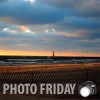
This recent image of the Great Lakes region at night is taken by a satellite with a low-light sensor that distinguishes night lights with much better spatial resolution and resolution of lighting levels than before. It was launched in October 2011 by NASA, the National Oceanic and Atmospheric Administration and the Department of Defense. More here.
